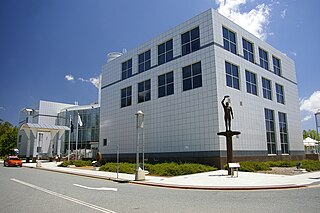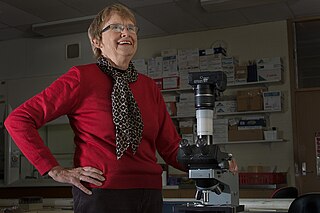Frederick Edmund Emery was an Australian psychologist. He was one of the pioneers in the field of organizational development, particularly in the development of theory around participative work design structures such as self-managing teams. He was widely regarded as one of the finest social scientists of his generation.

The Australian National University (ANU) is a public research university located in Canberra, the capital of Australia. Its main campus in Acton encompasses seven teaching and research colleges, in addition to several national academies and institutes.
A journalism school is a school or department, usually part of an established university, where journalists are trained. 'J-School' is an increasingly used term for a journalism department at a school or college. Journalists in most parts of the world must first complete university-level training, which incorporates both technical skills such as research skills, interviewing technique and shorthand and academic studies in media theory, cultural studies and ethics.

Questacon – The National Science and Technology Centre is an interactive science communication facility in Canberra, Australia. It is a museum with more than 200 interactive exhibits relating to science and technology. It has many science programs that are intended to inspire the children of Australia to love science.
The Master of Accountancy, alternatively Master of Science in Accounting or Master of Professional Accountancy, is a graduate professional degree designed to prepare students for public accounting; academic-focused variants are also offered.

Brian Paul Schmidt is the Vice-Chancellor of the Australian National University (ANU). He was previously a Distinguished Professor, Australian Research Council Laureate Fellow and astrophysicist at the University's Mount Stromlo Observatory and Research School of Astronomy and Astrophysics. He is known for his research in using supernovae as cosmological probes. He currently holds an Australian Research Council Federation Fellowship and was elected a Fellow of the Royal Society (FRS) in 2012. Schmidt shared both the 2006 Shaw Prize in Astronomy and the 2011 Nobel Prize in Physics with Saul Perlmutter and Adam Riess for providing evidence that the expansion of the universe is accelerating, making him the only Montana-born Nobel laureate.
Australia ICOMOS is a peak cultural heritage conservation body in Australia. It is a branch of the United Nations-sponsored International Council on Monuments and Sites (ICOMOS), a non-government professional organisation promoting expertise in the conservation of place-based cultural heritage. Its secretariat is based at the Cultural Heritage Centre for Asia and the Pacific at Deakin University.
Ralph Owen Slatyer was an Australian ecologist, and the first Chief Scientist of Australia from 1989 to 1992.
The ANU Joint Colleges of Science is the combined sciences faculty at the Australian National University. They deliver research and teaching in science, environment, medicine and health. The Colleges count five Nobel laureates including the current Vice Chancellor, Professor Brian Schmidt who jointly won the 2011 Nobel Prize in Physics. The Colleges also boast other prominent academics such as Graham Farquhar who is the first Australian to win a Kyoto Prize in Basic Sciences for his life's work in plant biophysics and photosynthesis, which has involved research on water-efficient crops and the impacts of climate change.
Joanne Nova is an Australian writer, blogger, and speaker. Born Joanne Codling, she adopted the stage name "Nova" in 1998 when she was preparing to host a children's television program. She is prominent for promoting climate change denial.

The academic structure of the Australian National University is organised as seven academic colleges which contain a network of inter-related faculties, research schools and centres. Each college is responsible for undergraduate and postgraduate education as well as research in its respective field.
The Coral Bell School of Asia Pacific Affairs is a constituent of the College of Asia and the Pacific, but was formerly part of the Research School of Pacific and Asian Studies, ANU, which was founded in 1946 as part of the Institute of Advanced Studies at the Australian National University in Canberra, Australian Capital Territory. In 2015 it was renamed in honour of Coral Bell, a leading Australian scholar of international politics.

Professor Hans-Albert Bachor is a German-born Australian research physicist.
Jennings Bryant was Distinguished Professor Emeritus at The University of Alabama (UA). Prior to his retirement in 2010, he was Communication and Information Sciences Distinguished Research Professor, holder of the Reagan Endowed Chair of Broadcasting, and Associate Dean for Graduate Studies and Research at UA. Jennings Bryant was married to Sara Poteat Bryant for 43 years. He and Sara were the parents of three children. The Bryants lived on a family farm in the Mountain Valley Rural Agricultural Historical District in Glenwood, North Carolina.

Inspiring Australia is an Australian national strategy for engagement with the sciences. Its goals include improving science communication and helping engage the Australian community with science. Inspiring Australia has rolled out a range of programs and expanded existing ones to help achieve its goals, including publishing reports from expert working groups, a Science Engagement Toolkit, Prime Minister's Prizes for Science and National Science Week.
Michael Miles Gore was a British-born Australian engineer, physicist, and science explainer, who worked at the Australian National University in Canberra. He was noted for being the founder of Questacon, the first interactive science centre in Australia.

Elizabeth Marchant Truswell is a former Chief Scientist at the Australian Geological Survey Organisation and is known for her application of recycled palynomorph distribution as an indicator of sub-ice geology.
Emeritus Professor Susan (Sue) Mary Stocklmayer,, is a science communicator who served as Director of the Centre for the Public Awareness of Science at the Australian National University (ANU) from 1998 to 2015.

The ANU College of Medicine, Biology and Environment is an Australian university college for the study of medicine, biology, and environment at the Australian National University (ANU), located in Canberra, the capital city of Australia.
Lee Constable is a science communicator, television presenter, children's author, and biologist who lives and works in Australia. She is best known for her work as a presenter on Scope between 2016–2020, Network Ten's science show aimed at children aged 7–13.








